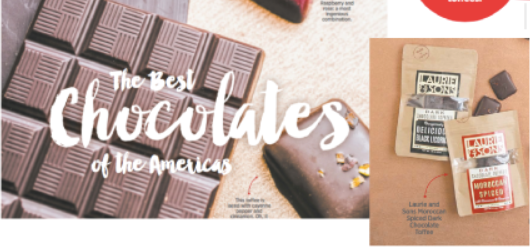
In the world of fine chocolate, most of us would assume that the best comes from Europe. After all, it was a European who first invented the chocolate bar in the 19th century. But in recent years, as more chocolate makers in the Americas have begun producing chocolate bars from scratch, they have refined their craft to the point of rivaling their counterparts across the Atlantic.
Most of the chocolates you find in stores are made by large chocolate manufacturing companies—like Hershey’s or Nestlé—that mass-produce candy from cocoa beans harvested at different plantations, with the addition of lots of sugar and artificial flavoring. Most chocolatiers make their confections out of chocolate that came from a manufacturer.
Artisanal chocolate makers, on the other hand, do everything themselves. Known as bean-to-bar chocolate, the process begins with directly trading with cocoa farmers, then going through the arduous process of sorting, roasting, winnowing, milling, and smoothing the beans into a chocolate mixture. The resulting product is rich with flavors as complex as wine or coffee—according to the terroir of where the beans are grown.
At the Americas semifinals of the 2015 International Chocolate Awards, a diverse group of artisans won for their outstanding chocolates. We tried some of the winners to introduce you, dear reader, to the stunning flavors you can experience in North and South American chocolate.
Hummingbird Chocolate
Canadian company Hummingbird Chocolate’s gold-winning Hispaniola 70% cacao hits you with a strong bitter taste at first. But soon, a fruity, cherry taste dominates—smooth and satisfying. Its silver award winner, the Zorzal 70% cacao, is a bit silkier, and brings notes of apricot to the front of the tongue. As the chocolate melts in your mouth, a tart, yet smoky accent comes up every so often, surprising the palate. It finally ends with a caramel-y taste.
Hummingbird Chocolate’s silver award winner Zorzal 70% cacao. (Samira Bouaou/Epoch Times)
Both bars are made only from beans grown in the Dominican Republic. The chocolate makers, Erica and Drew Gilmour, started off as aid workers in Afghanistan, helping local farmers. When the couple had their daughter, they decided to settle down and began looking into how to make chocolate from scratch. Hummingbird was thus born. Their beautifully designed bars are made in a workshop in Ottawa.
The Gilmours’ passion is evident in their product. “It’s a maddening craft that will take a lifetime to master, but allows little wins along the way just to keep you interested,” said Drew via email. And, after all, “What other best-quality food can you get for less than 10 bucks?” We’d have to agree with that.
Available outside of Canada by emailing shop@hummingbirdchocolate.com.
Pacari
Pacari, which sources and makes its chocolates in Ecuador, won awards in an impressive 13 categories. Its gold-winning Andean Lemon Verbena infuses its 60% cacao with the citrusy herb, making for a refreshing, soothing flavor. While tasting the smooth chocolate, you can sense the coolness of the lemon verbena through the nose.
Its other gold winner, Montubia 70%, has a distinctive nuttiness at the beginning. The flavor deepens as it stays in your mouth, ending on a luscious, sweet note.
Pacari’s gold winner, Montubia 70%. (Samira Bouaou/Epoch Times)
Meanwhile, the Andean Mint is perfect for mint lovers: its spearmint-like flavor is reminiscent of chewing gum. And for those who like fruit-flavored chocolate, the Passion Fruit is a fruity explosion worth trying, with a strong aroma and a tangy, flavor-forward taste. The fruitiness becomes more accentuated the longer you eat it, with a touch of bitter to keep the chocolate from becoming too saccharine.
Available from Pacari.com.
Rogue Chocolatier
Rogue Chocolatier, based in Massachusetts, takes a minimalist approach to its chocolate making. Unlike other artisans, it does not even use cocoa butter or milk, just pure cacao beans and cane sugar. Its chocolate tastes much like how you would imagine raw cacao beans to taste: earthy and unadulterated.
Rogue Chocolatier. (Samira Bouaou/Epoch Times)
Its Porcelana 80% comes from a special cacao variety that contains genetic traces of a type cultivated by the Mayans thousands of years ago. The chocolate has a salty, nutty, grassy profile, with just a hint of fruit at the end. This is definitely adult chocolate.
The Tranquilidad 75% is friendlier to our sweet tooth palates, with a mellow honey-like flavor that gets tart and fruity as you eat it. There’s also an underlying roasted taste that balances out the sweetness.
Available from RogueChocolatier.com.
Chocolopolis
Chocolopolis is a Seattle-based chocolate maker that also makes truffles by hand. Its truffles are as beautiful to look at as they are to eat. The lemon lavender truffle is so exquisite you barely have the heart to eat it: the shell is painted in pastel yellow and purple swirls, sprinkled with gold flecks.
Nonetheless, the lemon scent is too enticing. Biting into it is like eating a lemon meringue pie. As you finish the lemon, you get a whiff of the lavender, and in the end, are left to enjoy the smooth white chocolate shell.
The Madagascar truffle and the Raspberry Rose truffle from Chocolopolis. (Samira Bouaou/Epoch Times)
The Dominican Republic truffle is equally decadent, with a consistency like mousse cake. But it’s not cloyingly sweet—there’s a rum-like, slight bitterness to the ganache that keeps your palate excited.
The Madagascar truffle, by contrast, sweeps you away to a sweet spot immediately. The smooth, fudge-like texture is a perfect vehicle for the cherry-like tartness in the ganache.
Meanwhile, the Raspberry Rose truffle is fragrant and floral, but doesn’t taste artificial like many things that are labeled as rose-flavored. The treat melts in your mouth right away, and is evocative of eating a delicate cake.
Available from Chocolopolis.com.
Cacao Art
Miami-based Cacao Art uses only Venezuelan chocolate to create delectable bonbons infused with local Florida ingredients, like cardamom and Tupelo honey harvested from trees native to Florida.
The anise taste surprises you when you first bite into its gold-winning truffle, Anís y Papelón, leading to hints of licorice and cinnamon swirling in your mouth. You’re then left with the mild sweetness of the “papelón,” or raw cane sugar. This truffle achieves the near impossible in the world of truffles: it actually isn’t too sweet for a second helping.
Cacao Art’s gold-winning Anís y Papelón bonbon. (Samira Bouaou/Epoch Times)
The chocolate makers, originally from Venezuela, were inspired by a classic dessert from their home country called the “golfeado,” a pastry roll with papelón, anise, and cheese filling.
Available from CacaoArt.com.
Laurie and Sons
Laurie and Sons makes toffee candies and other chocolate snacks out of their kitchen in East Harlem. Their Moroccan Spiced Dark Chocolate Toffee throws you for a loop with cayenne pepper—the fiery spice slowly spreads to heat up your entire mouth. The cinnamon adds an extra kick, but the crunchy toffee soon soothes with its caramel-y goodness. It’s a fun treat that ensures your mouth won’t get bored.
Laurie and Sons’ Moroccan Spiced Dark Chocolate Toffee. (Samira Bouaou/Epoch Times)
Its Dangerously Delicious Black Licorice Toffee is an unlikely combination, but is impressive for making a licorice-non-believer like me enjoy it. The licorice flavor is toned down by a tinge of salt and its incredibly buttery toffee.
After spending a career in marketing and advertising, Laurie Pauker became interested in candy making while staying at home caring for her three sons. Her guiding principle is making candy that she can feel good about letting her children eat (no additives, organic, and sourced responsibly). She taught herself how to make nougats and truffles, but favors toffee, which she considers “the ultimate carrier of aroma, flavor, texture, and crunch.”
Available at La Marqueta, 1580 Park Ave., Harlem, or by ordering at LaurieandSons.com.
Castronovo
Castronovo’s award-winning chocolate bars have a magical caramel flavor that comes naturally from the beans. The Sierra Nevada 63%, made from Colombian beans, has that rich, silky-smooth caramel flavor, plus a slight tartness that invites you to keep eating. It’s addictively delicious.
Castronovo’s award winning chocolate, the Sierra Nevada 63%. (Samira Bouaou/Epoch Times)
The Dominican Republic 50% has an intense toffee flavor, exquisitely creamy in texture. It’s worth savoring as it melts slowly in your mouth.
Castronovo’s award winning chocolate, the Dominican Republic 50%. (Samira Bouaou/Epoch Times)
Denise Castronovo became interested in chocolate making through her academic work researching rainforest tree canopies. She discovered that harvesting cacao was actually beneficial to the rainforest ecosystem. Castronovo only uses heirloom beans from Latin America. At her Florida shop, patrons can also enjoy chocolate chip cookies and cocoa drinks made in house.
Available from CastronovoChocolate.com.
For the full list of winners, see InternationalChocolateAwards.com
